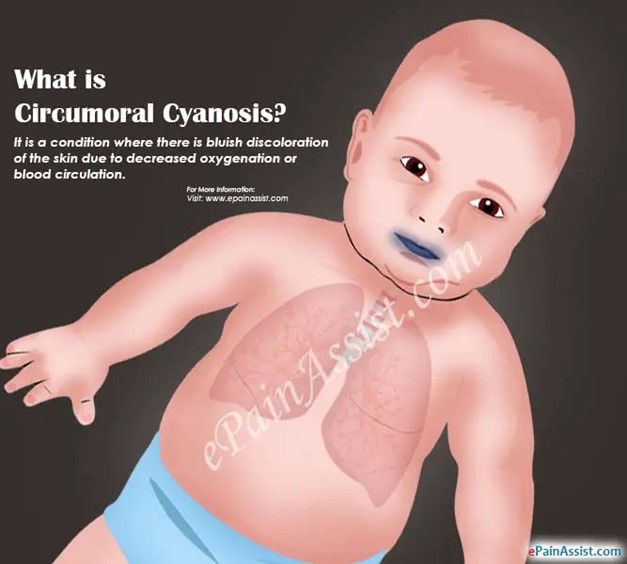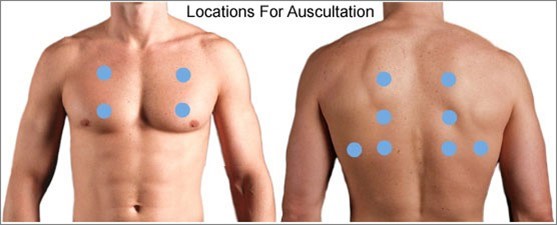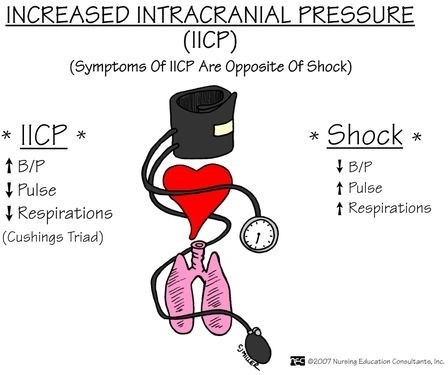The practical nurse (PN) receives shift reports for four newborns in the full-term newborn nursery. Which infant should the PN assess first?
The six-hour-old with a large sacral "stork bite".
The two-day-old with negative Ortolani's sign.
The ten-hour-old with circumoral cyanosis.
The one-day-old with a positive Babinski's reflex.
The Correct Answer is C
Circumoral cyanosis, which is bluish discoloration around the mouth, can be a sign of inadequate oxygenation. It suggests that there may be an issue with the infant's respiratory or cardiovascular system, potentially indicating respiratory distress or a cardiac problem. Prompt assessment and intervention are necessary to determine the cause of the cyanosis and ensure the infant's well-being.

A. The six-hour-old infant with a large sacral "stork bite" refers to a common birthmark caused by dilated blood vessels. While it may be important to assess the birthmark and document its presence, it is not an urgent concern requiring immediate attention.
B. The two-day-old infant with a negative Ortolani's sign refers to a specific maneuver used to assess for developmental hip dysplasia or dislocation. A negative Ortolani sign indicates that there is no evidence of hip dislocation. While it is important to assess the infant's hips and document the findings, it does not require immediate attention.
D. The one-day-old infant with a positive Babinski's reflex refers to an abnormal response in which the infant's toes fan out and the big toe dorsiflexes when the sole of the foot is stimulated. While a positive Babinski's reflex can be a normal finding in infants under a certain age, it is important to assess the infant's neurological status. However, it does not require immediate attention compared to the infant with circumoral cyanosis, which indicates potential respiratory or cardiovascular distress.
Nursing Test Bank
Naxlex Comprehensive Predictor Exams
Related Questions
Correct Answer is C
Explanation
When assessing an older client with left-sided heart failure (HF), the most important intervention for the practical nurse (PN) to implement is to auscultate all lung fields. Left-sided heart failure is characterized by the inability of the left ventricle to effectively pump blood, leading to fluid accumulation in the lungs. Auscultating all lung fields allows the PN to assess for the presence of abnormal lung sounds such as crackles, indicating pulmonary congestion.

In summary, when assessing an older client with left-sided heart failure, the most important intervention for the practical nurse (PN) to implement is to auscultate all lung fields. This allows for the detection of abnormal lung sounds associated with pulmonary congestion, a hallmark sign of left-sided heart failure.
Correct Answer is D
Explanation
The vital sign trends that indicate increased intracranial pressure (ICP) and should be reported to the charge nurse are:
Bradycardia: A slow heart rate can be a sign of increased ICP.
Irregular respiratory patterns: Abnormal breathing patterns, such as irregular or Cheyne-Stokes respirations, can be indicative of increased ICP.
Widening pulse pressure: An increased difference between systolic and diastolic blood pressure (widening pulse pressure) can be a sign of increased ICP.

A- Heart rate above 110 beats/minute, elevated respiratory rate, and hypotension: While an elevated heart rate and respiratory rate can be associated with increased ICP, hypotension (low blood pressure) is not typically seen in this condition. Hypotension can be a sign of other factors, such as hypovolemia or shock, which may or may not be related to the head injury.
B- Bounding pulse rate, groaning respiratory effort, and elevated blood pressure: Bounding pulse rate and elevated blood pressure are not specific to increased ICP. They can be influenced by other factors such as pain, anxiety, or medications. Groaning respiratory effort may indicate respiratory distress, but it is not directly related to increased ICP.
C- Thready rapid pulse, trembling, perspiration, weakness, and irritability: These signs and symptoms can be associated with various conditions such as anxiety, stress, or other physiological responses. While they may occur in the context of increased ICP, they are not specific to this condition alone.
Whether you are a student looking to ace your exams or a practicing nurse seeking to enhance your expertise , our nursing education contents will empower you with the confidence and competence to make a difference in the lives of patients and become a respected leader in the healthcare field.
Visit Naxlex, invest in your future and unlock endless possibilities with our unparalleled nursing education contents today
Report Wrong Answer on the Current Question
Do you disagree with the answer? If yes, what is your expected answer? Explain.
Kindly be descriptive with the issue you are facing.
